Minimum ten-year follow-up of cemented total hip replacement in patients with osteonecrosis of the femoral head
- PMID: 12180617
- PMCID: PMC1888371
Minimum ten-year follow-up of cemented total hip replacement in patients with osteonecrosis of the femoral head
Abstract
Between November 1970 and September 1984 the senior author performed fifty-three consecutive total hip arthroplasties with cement in forty-one patients with the diagnosis of osteonecrosis of the femoral head. Five hips in three patients with failed renal transplants requiring chronic hemodialysis were excluded. At the time of final review, a minimum of ten years after the procedure, twenty-one patients (twenty-eight hips) were living, fifteen patients (eighteen hips) had died, and two patients (two hips) were lost to follow-up. A minimum ten-year follow-up radiograph was obtained on twenty-two (79%) of the hips in surviving patients. During the follow-up period 17.4% of hips (eight hips) required revision: 13.0% (six hips) for aseptic loosening, 2.2% (one hip) for sepsis, and 2.2% (one hip) for recurrent dislocation. All eight revisions occurred in patients living at time of final review, giving a revision prevalence of 22.9% (17.1% for aseptic loosening, 2.9% for sepsis, and 2.9% for recurrent dislocation) in patients surviving ten years. The prevalence of revision of the femoral component for aseptic loosening was 6.5% (three hips) for all hips and 9.1% (three hips) in patients surviving at least ten years. The prevalence of femoral aseptic loosening, defined as those components revised for aseptic loosening and those that demonstrated definite or probable radiographic loosening, was 13.0% (six hips) for all hips and 28.6% (six hips) for hips with at least ten-year radiographic follow-up. The prevalence of revision of the acetabular component for aseptic loosening was 13.0% (six hips) for all hips and 18.2% (six hips) in patients surviving at least ten years. The prevalence of acetabular aseptic loosening was 15.2% (seven hips) for all hips and 29.2% (seven hips) for hips with at least ten-year radiographic follow-up. In patients with osteonecrosis of the femoral head survivorship was significantly inferior to that in the senior author's overall patient population with regard to revision for aseptic loosening (p=0.019), revision for acetabular loosening (p=0.01), revision for femoral loosening (p=0.008), and aseptic femoral loosening (p=0.004). Survivorship to aseptic acetabular loosening was not significantly different (p=0.32). Young age at the time of surgery significantly increased the risk of subsequent component loosening (p<0.008) and revision due to aseptic loosening (p<0.002). These findings demonstrate the relatively poor durability of cemented total hip arthroplasty in patients with osteonecrosis of the femoral head as compared to patients with other diagnoses and suggest that the younger age in this patient population compromises results.
Figures
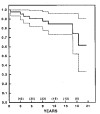
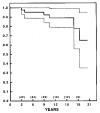
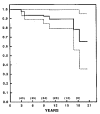
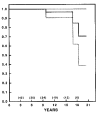
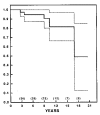
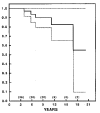






Similar articles
-
Charnley total hip arthroplasty with use of improved techniques of cementing. The results after a minimum of fifteen years of follow-up.J Bone Joint Surg Am. 1997 Jan;79(1):53-64. J Bone Joint Surg Am. 1997. PMID: 9010186
-
Total hip arthroplasty with cement and use of a collared matte-finish femoral component: nineteen to twenty-year follow-up.J Bone Joint Surg Am. 2008 Feb;90(2):299-306. doi: 10.2106/JBJS.G.00095. J Bone Joint Surg Am. 2008. PMID: 18245589
-
Total hip arthroplasty with a cemented, polished, collared femoral stem and a cementless acetabular component. A follow-up study at a minimum of ten years.J Bone Joint Surg Am. 2007 Jan;89(1):126-32. doi: 10.2106/JBJS.E.01214. J Bone Joint Surg Am. 2007. PMID: 17200319
-
A Meta-Analysis of Outcomes in Total Hip Arthroplasty Recipients Following Pelvic Irradiation.J Arthroplasty. 2019 Jul;34(7):1546-1552. doi: 10.1016/j.arth.2019.02.047. Epub 2019 Feb 27. J Arthroplasty. 2019. PMID: 30904364
-
Resurfacing arthroplasty in osteonecrosis of the hip.Orthop Clin North Am. 2005 Apr;36(2):231-42, x. doi: 10.1016/j.ocl.2005.02.005. Orthop Clin North Am. 2005. PMID: 15833461 Review.
Cited by
-
Osteonecrosis is not a predictor of poor outcomes in primary total hip arthroplasty: a systematic literature review.Int Orthop. 2011 Apr;35(4):465-73. doi: 10.1007/s00264-010-0979-7. Epub 2010 Feb 25. Int Orthop. 2011. PMID: 20182877 Free PMC article.
-
Femoral resurfacing in young patients with hematologic cancer and osteonecrosis.Clin Orthop Relat Res. 2008 Dec;466(12):3044-50. doi: 10.1007/s11999-008-0352-y. Epub 2008 Aug 5. Clin Orthop Relat Res. 2008. PMID: 18679763 Free PMC article.
-
Hip arthroplasty for treatment of advanced osteonecrosis: comprehensive review of implant options, outcomes and complications.Orthop Res Rev. 2016 Jun 28;8:13-29. doi: 10.2147/ORR.S35547. eCollection 2016. Orthop Res Rev. 2016. PMID: 30774467 Free PMC article. Review.
-
SAS weekly rounds: avascular necrosis.HSS J. 2009 Sep;5(2):99-113. doi: 10.1007/s11420-009-9107-x. Epub 2009 Mar 18. HSS J. 2009. PMID: 19294340 Free PMC article.
-
Modified trapdoor procedures using autogenous tricortical iliac graft without preserving the broken cartilage for treatment of osteonecrosis of the femoral head: a prospective cohort study with historical controls.J Orthop Surg Res. 2020 May 24;15(1):183. doi: 10.1186/s13018-020-01691-w. J Orthop Surg Res. 2020. PMID: 32448346 Free PMC article.
References
-
- Acurio MT, Friedman RJ. Hip arthroplasty in patients with sickle cell hemoglobinopathy. J Bone and Joint Surg. 1992;74-B(3):367–371. - PubMed
-
- Alpert B, Waddell JP, Morton J, Bear RA. Cementless total hip arthroplasty in renal transplant patients. Clin Orthop. 1992;284:164–169. - PubMed
-
- Amstutz HC, Grigoris P, Safran MR, Grecula MJ, Campbell PA, Schmalzried TP. Precision-fit surface hemiarthroplasty for femoral head osteonecrosis. Long-term results. J Bone and Joint Surg. 1994;76-B(3):423–427. - PubMed
-
- Arlot ME, Bonjean M, Chavassieux PM, Meunier PJ. Bone histology in adults with aseptic necrosis. J Bone and Joint Surg. 1983;65-A(9):1319–1327. - PubMed
-
- Ballard WT, Callaghan JJ, Sullivan PM, Johnston RC. The results of improved cementing techniques for total hip arthroplasty in patients less than fifty years old. A ten-year follow-up study. J Bone and Joint Surg. 1994;76-A(7):959–964. - PubMed
MeSH terms
LinkOut - more resources
Full Text Sources
Medical
